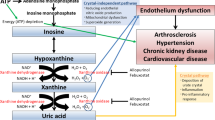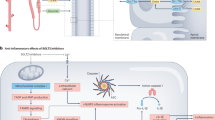Abstract
The role of uric acid (UA) in human physiology is subject to controversy. Either it is an important radical scavenger, a mostly neutral, waste metabolic product that may cause gout and kidney stones if elevated, or it is involved in the causation of hypertension, vascular and renal diseases. Recently we conducted a clinical trial to determine whether raising the serum UA levels through the oral administration of inosine is well tolerated and may benefit patients with multiple sclerosis. An important aspect of the safety profile is whether raising the serum UA levels elevates blood pressure. During the 1-year trial, blood pressure and serum UA levels were monitored in 16 patients. Both parameters were recorded throughout the trial that included 69 visits by patients at baseline and during the placebo phase as well as 138 visits while receiving inosine treatment. We have observed that although the serum UA levels increased significantly during the inosine treatment phase of the trial, from 4.2±0.8 to 7.1±1.7 mg per 100 ml, blood pressure remained unchanged, averaging 123±15/78±9. Our findings indicate that raising the serum UA levels to upper normal physiological levels for a period of up to 1-year does not influence blood pressure significantly.
This is a preview of subscription content, access via your institution
Access options
Subscribe to this journal
Receive 12 digital issues and online access to articles
$119.00 per year
only $9.92 per issue
Buy this article
- Purchase on Springer Link
- Instant access to full article PDF
Prices may be subject to local taxes which are calculated during checkout
Similar content being viewed by others
References
Wu XW, Lee CC, Muzny DM, Caskey CT . Urate oxidase: primary structure and evolutionary implications. Proc Natl Acad Sci USA 1989; 86: 9412–9416.
Wu X, Wakamiya M, Vaishnav S, Geske R, Montgomery Jr C, Jones P et al. Hyperuricemia and urate nephropathy in urate oxidase-deficient mice. Proc Natl Acad Sci USA 1994; 91: 742–746.
Rafey MA, Lipkowitz MS, Leal-Pinto E, Abramson RG . Uric acid transport. Curr Opin Nephrol Hypertens 2003; 12: 511–516.
Beckman JS, Koppenol WH . Nitric oxide, superoxide, and peroxynitrite: the good, the bad, and ugly. Am J Physiol 1996; 271: C1424–C1437.
Squadrito GL, Pryor WA . Oxidative chemistry of nitric oxide: the roles of superoxide, peroxynitrite, and carbon dioxide. Free Radical Biol Med 1998; 25: 392–403.
Whiteman M, Ketsawatsakul U, Halliwell B . A reassessment of the peroxynitrite scavenging activity of uric acid. Ann NY Acad Sci 2002; 962: 242–259.
Scott GS, Hooper DC . The role of uric acid in protection against peroxynitrite-mediated pathology. Med Hypotheses 2001; 56: 95–100.
Spitsin S, Koprowski H . Role of uric acid in multiple sclerosis [review]. Curr Top Microbiol Immunol 2008; 318: 325–342.
Watanabe S, Kang D-K, Feng L, Nakagawa T, Kanellis J, Lan H et al. Uric acid, hominoid evolution, and the pathogenesis in salt sensitivity. Hypertension 2002; 40: 355–360.
Johnson RJ, Kang DH, Freig D, Kivlighn S, Kanellis J, Watanabe S et al. Is there a pathogenetic role for uric acid in hypertension and cardiovascular and renal disease? Hypertension 2003; 41: 1183–1190.
Mene P, Punzo G . Uric acid: bystander or culprit in hypertension and progressive renal disease? J Hypertens 2008; 26: 2085–2092.
Markowitz CE, Spitsin S, Zimmerman V, Jacobs D, Udupa JK, Hooper DC et al. The treatment of multiple Sclerosis with Inosine. J Altern Complement Med 2009; 15: 619–625.
Eraranta A, Kurra V, Tahvanainen AM, Vehmas TI, Koobi P, Lakkisto P et al. Oxonic acid-induced hyperuricemia elevates plasma aldosterone in experimental renal insufficiency. J Hypertens 2008; 26: 1661–1668.
Mazzali M, Jeremy Hughes J, Kim Y-G, Jefferson A, Kang D-H, Gordon KL et al. Elevated uric acid increases blood pressure in the rat by a novel crystal-independent mechanism. Hypertension 2001; 38: 1101–1106.
Feig DI, Soletsky B, Johnson RJ . Effect of allopurinol on blood pressure of adolescents with newly diagnosed essential hypertension: a randomized trial. JAMA 2008; 300: 924–932.
Forman JP, Choi H, Curhan GC . Plasma uric acid level and risk for incident hypertension among men. J Am Soc Nephrol 2007; 18: 287–292.
Singh AK, Amlal H, Haas PJ, Dringenberg U, Fussell S, Barone SL et al. Fructose-induced hypertension: essential role of chloride and fructose absorbing transporters PAT1 and Glut5. Kidney Int 2008; 74: 438–447.
Acknowledgements
This work was supported by a grant from Commonwealth of Pennsylvania Department of Health to Biotechnology Foundation Laboratories (to HK) and grant from NIH/NCAM (AT 001301) to DCH.
Author information
Authors and Affiliations
Corresponding author
Ethics declarations
Competing interests
The authors declared no conflict of interest.
Rights and permissions
About this article
Cite this article
Spitsin, S., Markowitz, C., Zimmerman, V. et al. Modulation of serum uric acid levels by inosine in patients with multiple sclerosis does not affect blood pressure. J Hum Hypertens 24, 359–362 (2010). https://doi.org/10.1038/jhh.2009.83
Received:
Revised:
Accepted:
Published:
Issue Date:
DOI: https://doi.org/10.1038/jhh.2009.83
Keywords
This article is cited by
-
Association of plasma xanthine oxidoreductase activity with blood pressure affected by oxidative stress level: MedCity21 health examination registry
Scientific Reports (2020)
-
The Protective Effects of Inosine Against Chemical Hypoxia on Cultured Rat Oligodendrocytes
Cellular and Molecular Neurobiology (2011)



